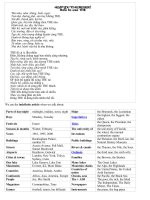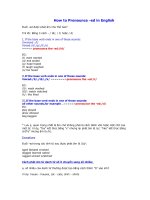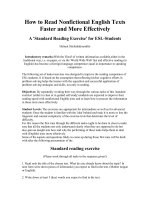Using ur voice how to give successful presentations
Bạn đang xem bản rút gọn của tài liệu. Xem và tải ngay bản đầy đủ của tài liệu tại đây (1.6 MB, 30 trang )
Welcome
to our
presentation
Members
The Voice
1
Author
Articulation
Part 1
Tips
-ic, -sion
-ce, -cy,-ty ,
-phy, -gy
• stress on the second syllable
from the bottom up.
• stress on the third syllable
from the bottom up
-ian, - id, -ible, •
Stress on syllables
-ish, -ive, -ous,
preceding these suffix
-ial, -ic, -ity
Part 2
How to stress on
word partnerships
Goals
Learn some
necessary word
partnerships
Tips
• Stress on the first word
Noun - noun •
Special cases: 10. consumer spending 11.
partnerships
market share 12. market forces
Verb - noun •
Stress on nouns
partnerships
Adjective• Stress on noun
noun
partnerships
Tips
Noun-and –
noun
partnerships
• Stress on the last noun of
phrases
Abbreviations • Stress on the last letter of word
Longer word
partnerships
• Stress on the main noun,
usually the last noun of phrase.
2
Author
Chunking
What is
chunking
???
Chunking is talking in chunks
of word.
Tips
Better to pause after stressed words, which
usually tend to be nouns and verbs.
Long chunks sound more fluent. Short
chunks sound more emphatic.
Put no stress on unimportant words like
to, at, of, a and the.
3
Author
Stress and Pacing
Stress
CHANGING
EMPHASIS CAN
ALTER
MEANING OR
IMPLICATION.
Example 1: We will dessert the
dessert by tomorrow
De-SERT
De-sert
Example 2:
I didn’t tell her you were stupid (I did not)
I didn’t tell her you were stupid –
( I told her someone else was
stupid)
Pacing
Aim
One simple way of keeping an
audience’s interest is to vary your
speech of speaking.
Slow down to make your most
important points.
4
Author
Intonation
What is
intonation?
A change or variation in
this music (or pitch) can
affect the meaning of
what we say.
Tips
Falling
intonation
• Very common in wh-questions
• also use when saying sth definite or clear sth.
Rising
intonation
• Common in yes-no questions
Fall-Rise
intonation
• Use at the end of statements when saying sth
not sure, unfinished thoughts, introductory
phrases, series of word.
• Use with requesting information
A Golden rule: vary the tone of
your voice









